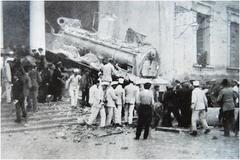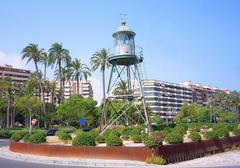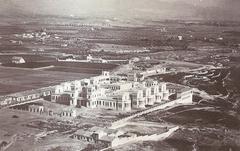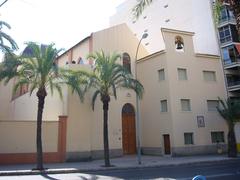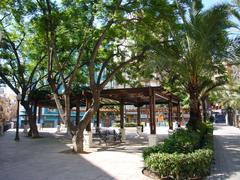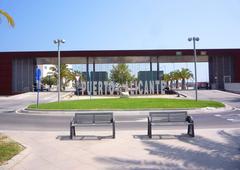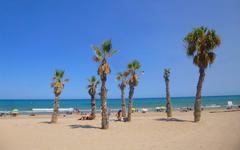Plaza del Pueblo Gitano Alicante: Visiting Hours, Tickets, and Historical Sites Guide
Date: 03/07/2025
Introduction
Nestled in the heart of Alicante’s lively Campoamor neighborhood, the Plaza del Pueblo Gitano is a dynamic cultural landmark honoring over six centuries of Romani (Gitano) presence and contributions in Spain. Inaugurated in December 2024, this public plaza not only commemorates the rich heritage and resilience of the Gitano community but also serves as an inclusive space for cultural celebrations, education, and social integration. With free admission and year-round accessibility, the plaza invites locals and tourists alike to engage with Romani traditions, enjoy artistic expressions such as flamenco music and dance, and participate in community initiatives that foster intercultural dialogue and mutual respect.
Ideally situated on Calle Marco Oliver—near notable sites like Estadio José Rico Pérez and Parque el Tossal—the plaza is easily accessible and enriches any Alicante itinerary. Its open spaces, colorful murals, symbolic sculptures, and commemorative plaques vividly narrate the journey and identity of the Roma people in Spain. The design incorporates the Romani flag’s colors and emblematic elements, reinforcing its role as a place of remembrance, celebration, and advocacy.
Beyond its cultural symbolism, Plaza del Pueblo Gitano functions as a community center where educational workshops, social advocacy, and festive events—most notably International Romani Day on April 8—take place. These activities help combat stereotypes, facilitate social cohesion, and empower the Gitano community. Collaboration between local organizations and municipal authorities ensures the plaza remains a beacon of inclusion and a platform for advancing Romani rights.
Whether you seek to deepen your understanding of Spain’s Romani heritage, enjoy vibrant cultural programming, or explore Alicante’s multifaceted urban landscape, Plaza del Pueblo Gitano offers a meaningful and accessible experience. For up-to-date visiting hours, event schedules, and guided tour options, consult official Alicante tourism resources and cultural organizations (El Español, Diario de Alicante, Alicante City Council).
Table of Contents
- Introduction
- Historical Background and Significance
- Social and Political Context
- Community Engagement and Cultural Events
- Location, Accessibility, and Visitor Information
- Visitor Experience and Highlights
- Frequently Asked Questions (FAQ)
- Conclusion
- References and Further Reading
Historical Background and Significance
The Plaza del Pueblo Gitano commemorates more than 600 years of Romani presence in Spain, dating back to the early 15th century. Historical accounts note that Alfonso V of Aragon granted safe passage to Romani groups in 1425, marking the beginning of their integration into Spanish society (El Español). In Alicante and the broader Valencian Community, the Romani community has contributed significantly to local culture and society, despite facing persistent discrimination and social exclusion.
The plaza’s inauguration, timed with the 600th anniversary of the Romani arrival in Spain, was spearheaded by the Federación Alicantina del Pueblo Gitano (FAPG), a federation dedicated to advocating for Romani rights. Its establishment stands as a public acknowledgment of the community’s enduring heritage and a step forward in promoting dialogue, inclusion, and mutual understanding (Diario de Alicante).
Social and Political Context
Despite progress, the Romani community in Alicante continues to encounter social barriers, including discrimination in public spaces and the healthcare system. Organizations such as the FAPG strive to address these challenges through mediation, advocacy, and educational programs. Collaborative events like the annual football match between the Romani community and local law enforcement exemplify efforts to foster respect and integration.
The plaza serves as a tangible platform for public declarations and manifestos, including the 2025 institutional statement marking the 600th anniversary of the Romani presence in Spain. These initiatives spotlight ongoing inequalities and call for collective action to advance the rights of the Gitano community (Diario de Alicante).
Community Engagement and Cultural Events
Cultural Celebrations
Plaza del Pueblo Gitano is a hub for cultural activities, most notably International Romani Day (April 8), when the plaza hosts performances, workshops, and communal gatherings. The raising of the Romani flag and the singing of the Romani anthem “Gelem Gelem” are highlights of these celebrations, reinforcing pride and intercultural exchange (Diario de Alicante).
Events and Artistic Expression
Music and dance—especially flamenco, with deep Romani roots—are central to the plaza’s events. Performances by renowned artists and local groups, workshops on Gitano crafts and language, and community fairs celebrating Gitano cuisine and entrepreneurship take place throughout the year (AlicanteGlobal, FSG Alicante).
Community Initiatives
The plaza is a focal point for educational outreach and advocacy, including school programs promoting awareness of Gitano heritage and workshops aimed at dispelling stereotypes. Community leaders and municipal authorities emphasize the importance of the plaza as a bridge between cultures and a symbol of unity.
Location, Accessibility, and Visitor Information
Location
Plaza del Pueblo Gitano is located on Calle Marco Oliver in the Campoamor neighborhood, between Avenida de Alcoy and Estadio José Rico Pérez (Todo Alicante, Mapcarta). The plaza’s central location places it within easy reach of key Alicante attractions, including Parque el Tossal and the Archaeological Museum of Alicante (MARQ).
Accessibility
The plaza is designed for inclusivity:
- Public Transport: Multiple bus routes run along Avenida de Alcoy. The TRAM Metropolitano de Alicante provides level boarding and accessible connections to the area.
- Pedestrian Access: Wide, step-free pathways and tactile paving ensure accessibility for wheelchair users and those with mobility aids.
- Parking: Nearby parking is available along Avenida de Alcoy and surrounding streets.
Visitor Guidelines
- Hours: Open daily from 8:00 AM to 10:00 PM; accessible year-round.
- Admission: Free of charge for all visitors.
- Guided Tours: Offered occasionally by local cultural organizations; check event calendars for availability.
- Safety: The plaza is well-lit and monitored; standard safety precautions apply.
Visitor Experience and Highlights
Design and Features
Plaza del Pueblo Gitano is thoughtfully designed to reflect Gitano culture:
- Open Gathering Spaces: Ideal for festivals, performances, and community events.
- Artistic Elements: Murals, mosaics, and sculptures narrate Romani history and traditions (AlicanteGlobal).
- Seating and Green Areas: Landscaped gardens and shaded benches provide a relaxing environment.
- Commemorative Plaques and Symbolic Motifs: The Romani flag’s colors and symbolic elements are integrated throughout the design.
Activities
- Cultural Events: Attend music, dance, and theater performances reflecting Gitano heritage.
- Workshops: Participate in craft, language, and history workshops.
- Community Fairs: Enjoy seasonal markets and food fairs highlighting Gitano entrepreneurship.
Nearby Attractions
Combine your visit with nearby sites such as:
- Santa Bárbara Castle: Offering panoramic city views.
- Explanada de España: A scenic promenade.
- Alicante Old Town (El Barrio): Known for historic streets and vibrant nightlife.
Frequently Asked Questions (FAQ)
Q: What are the opening hours of Plaza del Pueblo Gitano?
A: Open daily from 8:00 AM to 10:00 PM.
Q: Is there an entrance fee?
A: No, admission is free.
Q: Are guided tours available?
A: Occasionally, during special events—check with local cultural organizations or the tourist office.
Q: Is the plaza accessible for people with disabilities?
A: Yes, the plaza has step-free pathways, accessible seating, and is served by accessible public transport.
Q: What is the best way to get to the plaza?
A: Public buses, tram, walking, or accessible taxis are all convenient options.
Q: Are cultural events open to everyone?
A: Most events are free and open to the public; some workshops may require advance registration.
Conclusion
Plaza del Pueblo Gitano is a vibrant testament to the cultural richness, resilience, and ongoing advocacy of the Romani community in Spain. Its accessible location, inclusive design, and regular programming make it an essential stop for anyone exploring Alicante’s cultural landscape. From educational workshops and artistic performances to annual celebrations like International Romani Day, the plaza offers a unique space to learn, connect, and celebrate diversity.
Plan your visit during a cultural event to fully experience the plaza’s lively atmosphere. For updated information on events, guided tours, and visitor tips, consult official sources and consider downloading the Audiala app for real-time updates and audio guides.
References and Further Reading
- El Español: Interview with Félix Utrera
- Diario de Alicante: Alicante y la huella gitana
- Todo Alicante: Inauguración de la plaza
- Alicante City Council: Reconocimiento a la aportación gitana
- AlicanteGlobal: Apertura de la plaza en Campoamor
- AlicantePlaza: Reconocimiento oficial
- Mapcarta: Localización de la plaza
- FSG Alicante: Mercaemprende y actividades
For more details and cultural tips, download the Audiala app and follow our social media channels for the latest updates on Alicante’s cultural landmarks and events.
